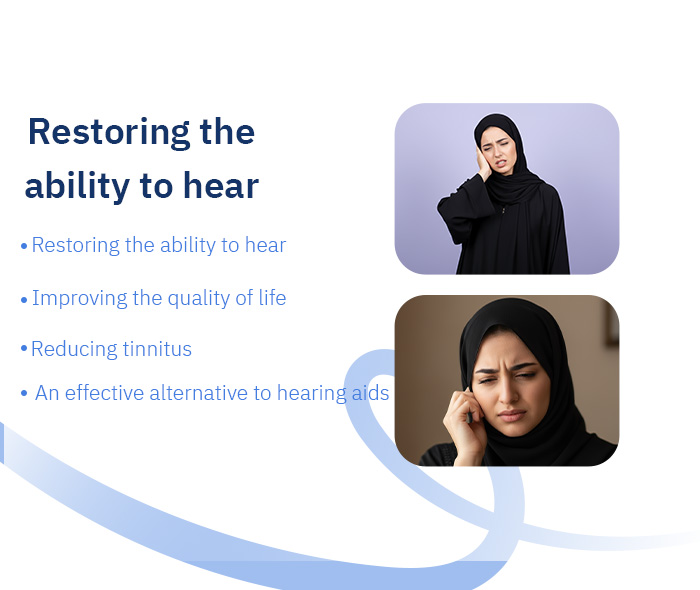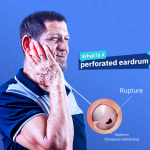Stapes Otosclerosis
Stapes Otosclerosis is a condition that affects the smallest bone in the human body—the stapes. Despite its tiny size, this bone plays a crucial role in the hearing process. Located in the middle ear, the stapes serves as the final bridge that transmits sound vibrations from the middle ear to the inner ear. When the stapes becomes hardened or stiffened due to otosclerosis, it can no longer vibrate effectively, leading to progressive hearing loss.
In this article, we shed light on the importance of this tiny yet vital bone, its essential function, and the health issues that can affect it.
- What is the Stapes Bone?
- Anatomical structure of the Stapes Bone
- What is the stapes surgery?
- Causes of stapes otosclerosis (Ear Bone Calcification)
- Symptoms of stapes otosclerosis (Ear Bone Calcification)
- How is stapes surgery performed?
- Importance of stapes surgery
- Risks and complications of stapes surgery
- Post operative care after stapes surgery
- When does hearing return after stapes surgery?
- Is stapes surgery dangerous?
What is the Stapes Bone?
The stapes bone is the smallest bone in the human body, and despite its tiny size, it plays a major role in the hearing process, located in the middle ear, it serves as the final bridge that transmits sound vibrations to the inner ear. When it becomes hardened or stiffened, a condition known as otosclerosis, hearing ability is directly affected.
In this article, we shed light on the importance of this tiny yet vital bone, its essential function, and the health issues that can affect it.
Anatomical structure of the Stapes Bone
The stapes resembles the shape of a stirrup used in saddles, and it is composed of the following parts: head, neck, two crura (or limbs), and a base (footplate).
- Head: The head, or apex, is concave and covered with cartilage, it connects to the lenticular process of the incus bone.
- Neck: This is the narrow part located just below the head, it serves as the attachment point for the tendon of the stapedius muscle.
- Crura (Limbs): The stapes has two bony limbs known as the anterior crus and the posterior crus, these extend from the neck and join at the base. The anterior crus is shorter and less curved than the posterior crus, the space between the two crura is called the obturator foramen.
- Base (Footplate): Also known as the footplate, it is a flat, oval-shaped plate that connects to the limbs and neck. The base is attached to the oval window of the inner ear, where it transmits sound vibrations into the cochlea.
What is the stapes surgery?
Stapes replacement surgery is a delicate surgical procedure used to treat hearing loss caused by otosclerosis, a condition in which the spongy bone around the base of the stapes becomes hardened, this hardening prevents the normal transmission of sound waves to the inner ear.
The goal of this procedure is to improve hearing by removing the immobilized stapes bone and replacing it with a precise prosthetic implant, this artificial stapes restores the proper transmission of sound vibrations to the inner ear, thereby enhancing auditory function.
Causes of stapes otosclerosis (Ear Bone Calcification)
Stapes otosclerosis is one of the common causes of hearing loss, it occurs when the small stapes bone becomes fixed and loses its ability to vibrate within the middle ear, several key factors may contribute to this stiffening, including:
- Genetic factors: Heredity plays a major role, as the condition is often seen to run in families.
- Fluoride imbalance in the body: Disruptions in fluoride levels can affect bone structure, including the stapes, increasing the likelihood of calcification.
- Abnormal bone growth in the middle ear: Certain bone growth disorders within the middle ear can result in the formation of extra or incompletely developed bones, which interfere with the normal movement of the stapes.
Symptoms of stapes otosclerosis (Ear Bone Calcification)
Symptoms of stapes otosclerosis typically begin gradually and may worsen over time, the most common symptoms include:
- Tinnitus: A persistent or intermittent noise in the ear, often described as buzzing or ringing, it is one of the earliest and most common symptoms.
- Dizziness or Vertigo: A sense of imbalance or spinning, particularly in more advanced stages of the condition.
- Gradual hearing loss: The most noticeable symptom, which usually begins in one ear and may later affect the other.
How is stapes surgery performed?
1)Surgical preparation
The procedure is performed under either local or general anesthesia, depending on the patient’s condition and the surgeon’s recommendation, the inner part of the ear canal is gently opened, and the skin of the canal and the eardrum are lifted to expose the tiny auditory bones in the middle ear, especially the stapes.
2)Removal of the hardened stapes
Once the stapes is exposed, it is partially or completely removed depending on the extent of the hardening, in some cases, a small hole is made in the base (footplate) where the stapes was attached.
3)Placement of support tissue
A small piece of tissue, usually taken from the temporalis muscle or mucosal lining through a small incision above the ear, is placed over the small hole created during removal, this helps reduce the risk of fluid leakage from the inner ear.
4)Insertion of the prosthetic implant
An artificial stapes (commonly made of titanium or other biocompatible materials) is implanted in the same position as the original bone, it is carefully positioned to connect the incus (anvil) with the oval window, ensuring effective sound vibration transmission.
5)Repositioning of tissues
After securing the prosthetic in place, the eardrum and ear canal skin are returned to their original positions, and the external surgical incision is gently closed.
Importance of stapes surgery

- Restoring hearing ability: The primary goal of the surgery is to improve or restore hearing in patients with hearing loss caused by stapes otosclerosis, reducing their dependence on hearing aids.
- Enhancing quality of life: Regaining the ability to hear improves daily communication, boosts self-confidence, and reduces the social isolation that often accompanies hearing loss.
- Reducing tinnitus: In some cases, the surgery helps alleviate or even eliminate tinnitus, a common and bothersome symptom associated with stapes fixation.
- Effective alternative to hearing aids: For patients who do not prefer or do not benefit from hearing aids, stapes surgery offers a long-term and effective surgical solution.
Risks and complications of stapes surgery
Stapes replacement is a highly delicate procedure, and its success largely depends on the surgeon’s expertise, however, like any surgical intervention, it carries some potential risks, including:
- Hearing loss: In rare cases, hearing may worsen after the surgery, either temporarily or permanently.
- Tinnitus: Some patients may experience ringing in the ear following the procedure, although this is uncommon.
- Dizziness: A sensation of vertigo may occur after surgery, but it usually subsides within a day or two.
- Facial muscle weakness or paralysis: The facial nerve, which controls facial movements, runs close to the middle ear. In rare cases, it may be affected, leading to temporary difficulty smiling or closing the eye.
- Taste changes or dry mouth: Temporary changes in taste or dry mouth may occur due to nearby nerves being affected, but these symptoms generally improve over time.
Post operative care after stapes surgery
During the recovery period after stapes surgery, there are several important precautions that patients must follow to ensure a successful outcome and proper healing of the ear:
- Avoid strenuous activities or sudden movements: Patients may begin light movements at home the day after surgery. By the end of the first week, simple daily activities can be resumed, but any heavy physical exertion should still be avoided.
- Keep water out of the ear: To prevent infections or complications, it’s essential to avoid getting water into the operated ear, patients should also refrain from forceful sneezing or blowing their nose, as this can create pressure in the middle ear and affect the stability of the implanted prosthesis.
When does hearing return after stapes surgery?
The ear typically takes about four weeks to fully heal following stapes replacement surgery, most patients begin to notice a significant improvement in hearing before the end of the fourth week.
Is stapes surgery dangerous?
Stapes replacement surgery is considered a precise but generally safe procedure when performed by a skilled and experienced surgeon, Like any surgery, it carries some potential risks such as infection, partial hearing loss, or tinnitus. However, most patients experience substantial hearing improvement without serious complications.







